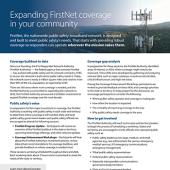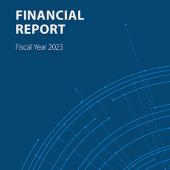The First Responder Network Authority (FirstNet Authority) and FirstNet were created out of a need for interoperable communications among first responders. When major events and incidents occur, public safety agencies must work together to serve and protect the community.
The National Capital Region is a densely populated region made up of over 24 counties and cities. As they work together nearly every day, local, state, and federal agencies in the area must efficiently communicate and share data as they respond to events and emergencies.
Metropolitan Washington Council of Governments is Born
In 1957, government officials from the District of Columbia, Virginia, and Maryland invited local jurisdictions to gather in order to face challenges effectively as a region. More than 40 public officials accepted the invitation, and the group gathered for the first meeting of what would become the Washington Metropolitan Regional Conference.
Today, that organization, now known as the Metropolitan Washington Council of Governments, or COG, continues to find cooperative solutions to regional challenges. COG’s 300-person membership represents 24 local governments, Virginia and Maryland state legislatures, and the U.S. Congress. With committees focused on topics ranging from transportation and air quality to public safety and emergency preparedness, COG discusses a wide array of issues and develops solutions that benefit all jurisdictions.
A History of Building Interoperable Communications
On January 13, 1982, tragedy struck the National Capitol Region. A severe snowstorm caused Air Florida Flight 90 to crash into the Fourteenth Street Bridge. On the same day, a fatal Metrorail train crash caused additional confusion and chaos. These two accidents taxed resources and challenged jurisdictions across the region. In the aftermath, COG created the region’s first coordinated disaster response plan. As emergency communications were inadequate during the response to these events, COG began to discuss interoperability for public safety communications.
Since then, COG has evolved and advanced interoperable communications for public safety. Managing Director of Homeland Security and Public Safety for COG Scott Boggs explains the importance of approaching interoperability as a region, “Although emergencies start locally, they often grow and stress resources regionally. Addressing interoperability beforehand, even in small ways, means a more seamless approach when large emergencies occur.” COG has advanced regional interoperability solutions through sponsoring shared radio caches, coordinating CAD (computer-aided dispatch) connectivity across agencies, organizing video solutions that benefit all jurisdictions, and more. COG continues to look at innovative solutions for public safety interoperability, including how FirstNet can benefit the region’s first responders.
Interoperability Today
Today, COG’s Interoperable Communications Regional Programmatic Working Group (IC RPWG) brings together individuals from across the National Capital Region to discuss and enhance communications. Representatives from multiple emergency support functions – including transportation, chief information officers, police, fire, emergency communications, and security officers – are involved to ensure every aspect of interoperability is considered as agreements are formed.
COG committees and working groups compile Memorandums of Understanding (MOUs) on high-level issues such as shared radio systems, encryption, and information sharing, to establish how jurisdictions will cooperate during incidents and planned events.
Communications technology and the needs of first responders are constantly evolving. As new issues arise, the group quickly adapts through amendments to existing MOUs. IC RPWG Chair Dave Mulholland believes collaboration is the greatest benefit to public safety working cross-jurisdictionally to tackle important issues, such as interoperability. He says, “The value of having people from different organizations contributing to the conversation is that you have that collective harnessing of all of those perspectives, all of their experience, which ultimately leads to a better product.”
In reflecting on COG and regional coordination, Scott Boggs stated, “You’re always going to be stronger together than you are as an individual agency. The more you collaborate, the more value you will see. We solve a lot of issues with regional coordination through COG. And the relationships we’ve developed and maintain will benefit the region during the next threat we have to tackle collectively. If there is trust, there is a willingness to work together to solve problems.”
Integrating FirstNet
When the FirstNet Core launched in 2018 and agencies began adopting the network, it gave public safety agencies another option for interoperability – not only for voice, but for video, data, and more. The IC RPWG incorporates FirstNet into interoperability discussions to see what policy and governance decisions are necessary to ensure seamless operations in the National Capital Region.
One of the first pieces the group has reviewed is FirstNet Central, the control dashboard for agency use that features tools such as Uplift and the Network Status Tool, as well as application and billing management. The IC RPWG recognized the need to ensure jurisdictions in the region understood FirstNet Central, its capabilities, and key terms used in relation to FirstNet. The group developed a brochure on the Five Top Things to Know About FirstNet Central to provide baseline information on the portal and key features. As Dave Mulholland explained, “It allowed us to cut through the confusion and make sure everyone knew what we were talking about.”
After creating the brochure, the IC RPWG began looking at regional policies and governance needed for the Uplift tool within FirstNet Central. Uplift gives agencies the ability to increase the priority level of partner agencies – which can include utilities, hospitals, and other government agencies – during an event, allowing them to communicate with first responders and one another during the incident. The group created an amendment to an existing MOU that requires public safety agencies to notify agencies in another jurisdiction if they need to uplift their users in that jurisdiction. This allows all agencies to have a better understanding of who has priority network access. In the event a major incident occurs, this will help mitigate any potential misunderstandings about uplifting partners in other jurisdictions.
Collaboration Benefits Public Safety
With FirstNet bringing more tools and resources to the field, public safety agencies will adapt operations to utilize the new technology. More situational awareness will give responders more information, when and where they need it. This new technology will also bring more opportunities for agencies to interoperate, and it is important for jurisdictions to work with neighboring agencies to address possible conflicts or challenges before they arise. COG’s IC RPWG is looking closely at the effect FirstNet will have on the National Capital Region and taking steps to address policy and governance challenges, benefiting public safety across the region.
“Everyone in the IC RPWG brings a different perspective to every meeting. As we discuss the issues that we face as a region, working together with those different perspectives is what makes us successful,” said Dave Mullholland. “Those relationships and partnerships are what allows us to have the difficult conversations and come up with mutually beneficial solutions.”
Similar actions can be taken by other regions. Having conversations and discussing issues before an incident occurs can help mitigate potential problems during an emergency. Technology like FirstNet is built to help first responders communicate seamlessly, and early and regular collaboration ensures agencies can use these tools to their full advantage.
Learn more about how FirstNet is transforming public safety communications — contact your local FirstNet Authority Public Safety Advisor and sign up for our discipline newsletters. Follow us on Twitter, Facebook, Instagram, and LinkedIn for the latest FirstNet Authority updates.
For information on FirstNet products and services or to access your subscriber account, visit FirstNet.com.




















